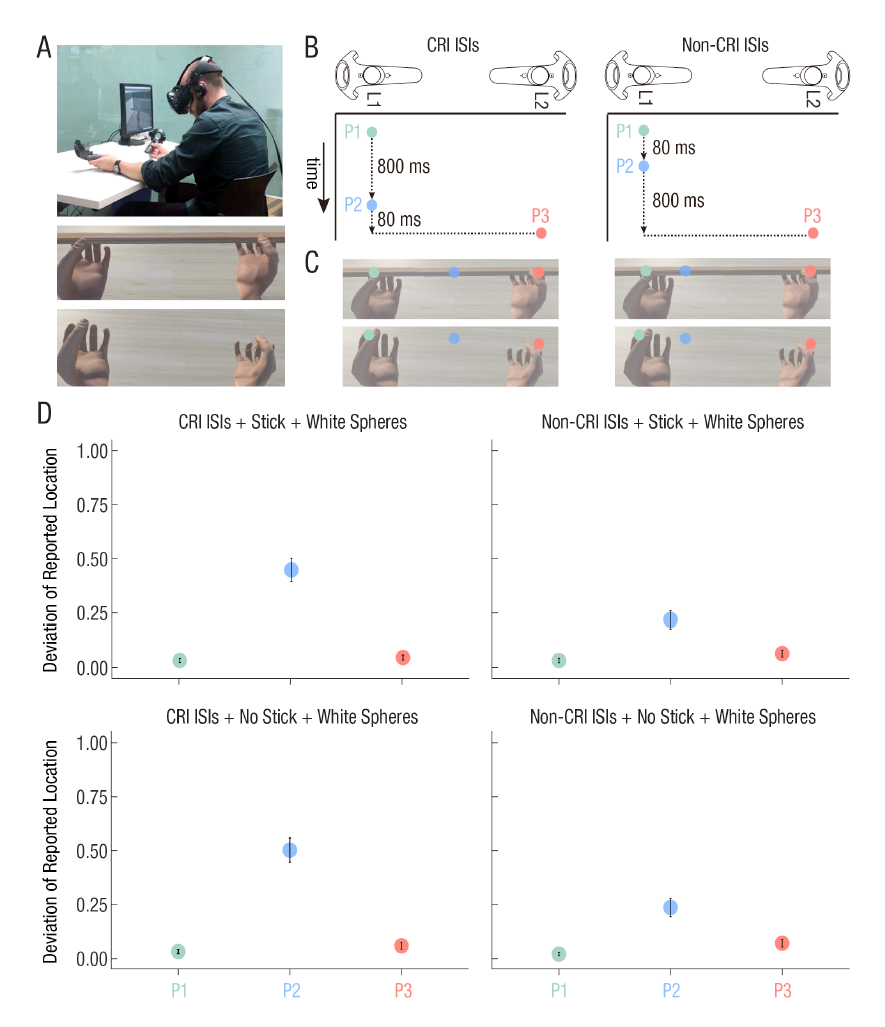Figure 1: Using the Cutaneous Rabbit Illusion to create an Out-of-the-Body Touch Illusion. (A) The posture of the participants during the experiment (top), and the first person perspective of the hands as seen through he HMDs during the conditions when a virtual stick was rendered between the virtual hands (middle), and when it was not (bottom). (B) A schematic overview of the spatio-temporal relationship between each vibrotactile pulse (P1-P3) delivered via the left and right HTC Vive controllers. (C) Typical reported location for each Pulse (P1-P3) when the cutaneous rabbit ISIs were used both when the stick was present (top left) and when it was not present (bottom left), and when the non-cutaneous rabbit ISIs were used, both when the stick was present (top right) and not present (bottom right). (D) Mean deviation of the participants’ reported location for each vibrotactile pulse in the conditions in which the cutaneous rabbit illusion ISIs were used and a stick was present (top left) or absent (bottom left), and when the non-cutaneous rabbit illusion ISIs were used and the stick was present (top right) or absent (bottom right). White spheres were presented simultaneously with each vibrotactile pulse. The second white sphere presented in a sequence was always presented in the intended illusory location (i.e., between the left and right hands). Error bars represent +/- 1 SEM.
Figure 2: The Out-of-the-Body Touch Illusion in Experiment 2 when no additional visual cues (i.e., white spheres) were used. Mean deviation of perceived location for each pulse when the cutaneous rabbit illusion ISIs were used and when a virtual stick was either present (left) or absent (right). Error bars represent +/- 1 SEM.
Figure 3: An Out-of-the-Body Touch Illusion from ’Funneling’. (A) The images depict the posture of the participants during the experiment (top), and the first person perspective of the hands as seen through he HMDs (bottom). (B) A schematic overview of the funneling technique by which linearly modulating the amplitude of vibrotactile stimuli simultaneously delivered to participants via the left and right Oculus Rift controllers elicits the illusory perception that a pulse occurs in the space between the hands. (C) The colored dots indicate participants’ typical reported location for each amplitude modulation (P1-P5). (D) Mean reported location of each pulse type (P1-P5) for when additional visual stimuli (i.e., small white spheres) were also presented in the intended illusory location (Spheres Condition) and when no additional visual stimuli were presented (No Spheres Condition). Error bars represent +/- 1 SEM.
Expanding The sense of Touch outside the Body
We usually assume that our sense of touch is limited to points of physical contact with our skin. However, certain tactile illusions such as the 'cutaneous rabbit' and 'tactile funneling' illusions demonstrate that this is not always the case. Virtual reality provides a unique testbed for exploring the interaction of our sense of sight with our other senses. Here, we explored whether our sense of touch could be expanded to virtual objects we are holding (in the virtual world, but not in the real world) or even to the empty space that surrounds us. We did this by combining visual cues in the immersive virtual environment with the techniques used to elicit the aforementioned tactile illusions. We found that indeed, under certain conditions, one can experience a sense of touch on virtual objects, and even in the empty space between one's hands. The results from these studies are published in the Proceedings of the 15th ACM Symposium on Applied Perception. Click here to read.
Paper Title: Expanding the Sense of Touch Outside the Body
Paper Abstract: Under normal circumstances, our sense of touch is limited to our body. Recent evidence suggests, however, that our perception of touch can also be expanded to objects we are holding when certain tactile illusions are elicited by delivering vibrotactile stimuli in a particular manner. Here, we examined whether an extra-corporeal illusory sense of touch could be elicited using vibrotactile stimuli delivered via two independent handheld controllers while in virtual reality. Our results suggest that under the right conditions, one’s sense of touch in space can be extended outside the body, and even into the empty space that surrounds us. Specifically, we show, in virtual reality, that one’s sense of touch can be extended to a virtual stick one is holding, and also into the empty space between one’s hands. These findings provide a means with which to expand the sense of touch beyond the hands in VR systems using two independent controllers, and also have important implications for our understanding of the human representation of touch.


